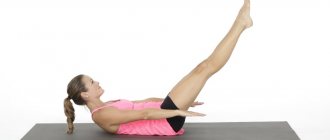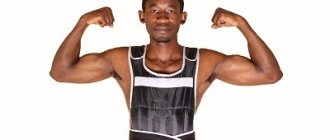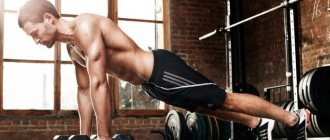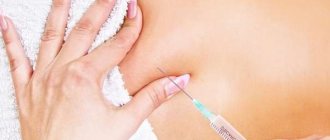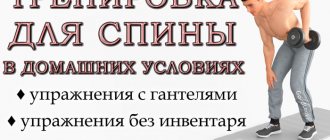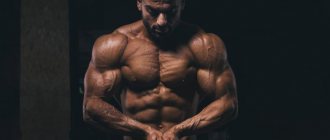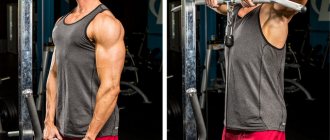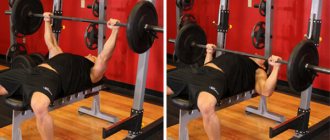Every time we grab an apparatus with our hands (this can be hanging on the bar, biceps curls, all kinds of rows), the inside of the forearms is loaded. This part of the forearms, as a rule, receives sufficient indirect load during the training process, and athletes often do not pay special attention to it and do not specifically train it.
The outer part of the forearm is an important muscle group, which in many athletes is often lagging in development because, unlike the inner part of the forearms, it does not receive load during exercises on the main muscle groups.
What will you get if you decide to pump up your forearms?
While they complement your look, they will also help you develop strength and functionality when lifting weights, and will later help you build mass in other areas such as your back, shoulders and biceps.
The forearms are indeed stimulated through lifting movements such as bending, lifting, and chin-ups/pulldowns, but in order for an athlete to reach their full potential and build strength in their forearms (especially if they are a weak point), they must incorporate specific training into their program . However, this does not mean that you need to do one or two movements at the end of your arm training day and perform the exercises at minimal intensity.
Can't wait to start training your forearms? We have prepared for you a basic advanced program that is suitable for all levels of training. Take it on a separate day of training or combine it with back/leg training.
Training your grip
An important element of our training is exercises to increase grip strength. As you remember, for this purpose we used a tennis ball, wrist expanders, even a barbell. For those who missed this lesson, let me remind you.
I think everyone knows what to do with an expander. Surely every man, at least in childhood, had this mini-simulator in his arsenal. Remember how your forearm got clogged when you exercised with it. This is despite the fact that its main focus is still the brush.
Now the ball. Just take it in your palm and press it in with your fingers. The same can be done with one thumb. In general, refer to our workout for the hand and fingers.
We need pancakes so that we can lift them with just our fingers. To do this, fold two pancakes, start with two 5gk each, take them on top with your fingers, lift them, and try to hold them for as long as possible. We considered this too.
What we haven't discussed yet is kettlebell exercises. Naturally, this requires appropriate physical training, but it’s probably hard to think of anything better than strength training for grip. So, grab a weight. Starting position: legs spread wide, butt sticking out, back arched. This position gives you stability. The weight stands between the legs. Grab a kettlebell and use your body momentum to lift it toward your chest. However, you should not press it, but hold it at arm's length, with your elbow bent at an angle of 90 degrees. Look at the photo to understand how everything needs to be done correctly. I hope everything works out for you.
Having analyzed all the really best and most effective exercises, let's try to create a program.
How to pump up your forearms
Hammer grip dumbbell curls
- 3 sets of 10-15 reps
- Body part: Biceps Equipment: Dumbbells
Hammer grip bicep curls on a Scott bench
- 3 sets of 10-15 reps
- Body part: Biceps Equipment: Dumbbells
Biceps curl on the lower block
- 3 sets of 10-15 reps
- Body Part: Biceps Equipment: Block
Wrist Curl on Dumbbell Bench, Palms Down
- 3 sets of 10-15 reps
- Body part: Forearms and wrists Equipment: Dumbbells
Bend the wrists on the lower block while sitting on a bench
- 3 sets of 10-15 reps
- Body Part: Forearms and Wrists Equipment: Block
Add to Calendar * Add to My Workouts * Print Workout
* — The service is in beta testing
A quality set of forearm exercises deserves the same attention and discipline as squats or presses. A well thought out plan of action that includes proper volume, intensity and use of different angles is the best way to achieve maximum development.
How to properly train your forearms?
When training the muscles of the forearms, you need to stop thinking about the fact that these are the forearms and focus your attention on the fact that these are primarily the grip muscles. Therefore, in order to train them correctly, so that they are not only big, but also functionally strong, it is necessary to respect their function, i.e. train them in isometric mode. In this case, any hanging, holding various objects, will be much more effective in this regard than any bending and extension with a barbell or dumbbells in the gym. As for ordinary traditional exercises, the adaptation of the muscles being loaded is directly proportional to the angle in the joint with which the movement is performed. Those. if you are doing wrist curls, do them at maximum amplitude, or if you are weighing or holding a weight, then try to twist your hand slightly.
A quick lesson in forearm anatomy
Surprisingly, the forearms are a complex group of small muscles with several functions. The brachialis and brachioradialis muscles help flex the arm at the elbow and assist the forearm during flexion. These muscles work during all flexion movements. The pronator teres muscle helps the forearm in the prone position, as well as when bending the arm at the elbow joint. The flexor muscles - palmaris longus, flexor carpi radialis and flexor carpi ulnaris - flex the palm, and the extensor muscles - ulnaris and extensor carpi radialis brevis - extend it.
To tone your forearms in a balanced manner, you need a comprehensive resistance training program that includes exercises for all parts of the forearm.
Forearm muscles - “big company”
The forearms consist of a large number of large and small muscles. These are flexor muscles, which are located on the inner sides of the arms, in the interval from the elbows to the hands, and extensor muscles, covering the outer side of the upper limbs. To work the forearms, it is also worth paying attention to the pronator-supinator muscles, the brachioradialis muscle and the brachyradialis, which forms the size and width of the arm below the elbow joint. These problems can be solved using special “sets” of exercises.
Whatever type of training you choose, remember the basic rules for success:
- follow the technique carefully;
- don’t chase weight;
- keep the pace slow.
The most effective way to conduct training is with a two-day break and alternating exercises.
A person who has never done physical labor has very fragile wrists. If you belong to this category, try to do without weights at first.
Bodymaster.ru recommends Training Plans:
Pay attention to complex biceps exercises, especially in the first half of the workout. When working with dumbbells for biceps, the muscles of the forearms are also included in the work. Several joints work at once, which increases the area and depth of the fibers involved. When working with dumbbells only with the hands (flexion/extension of the wrists with any grip), you can only count on “pumping” the forearms or detailing the muscles if you perform many repetitions with a light or medium weight.
The training program must necessarily include exercises for all muscle groups of the arms. It is advisable to change the choice of specific exercises and the sequence of their implementation from training to training - this will improve muscle growth. In this option, we have selected a combination of isolating and compound exercises for the forearms. Ideally, perform it in circles, from 2 to 4 according to your level of training.
A little theory
Without a clear understanding of how a particular muscle works, truly effective training is impossible. In order to know how to pump up muscles, you need to have at least a minimal understanding of what they consist of and how they perform contractions. Below we will talk about the anatomy of this group and how you can pump up your forearm muscles at home.
The forearm extends from the wrist to the elbow. We will not specifically give the Latin names of each muscle; we will limit ourselves to only general designations of muscle groups performing one function.
So, the largest muscle group of the forearm is the brachioradialis. Its task is to help the biceps in its work. She bends her arm slightly from a straight position, allowing the biceps to contract. This muscle group makes it possible to perform exercises such as pull-ups, barbell and dumbbell curls, etc.
The second largest muscle group is the flexor and extensor muscles of the fingers. Thanks to them, it is possible to clench your hand into a fist and unclench it. Without them, we would not be able to hold a fork in our hands.
The third is the muscles that make the wrist move. They are the ones who perform the movements of the hand up, down, left and right. They also provide a shock-absorbing effect.
Forearm Workout at Home: Reducing Wrist Tension
Wrist Curls on a Dumbbell Bench, Palms Up
- 3 sets of 10-15 reps
- Body part: Forearms and wrists Equipment: Dumbbells
Wrist Curl on Dumbbell Bench, Palms Down
- 3 sets of 10-15 reps
- Body part: Forearms and wrists Equipment: Dumbbells
Hammer grip dumbbell curls
- 3 sets of 10-15 reps
- Body part: Biceps Equipment: Dumbbells
Medium grip push-ups
- 3 sets of 15 reps
- Body Part: Chest Equipment: No
Close grip push-ups
- 3 sets of 10 reps
- Body Part: Chest Equipment: No
Add to Calendar * Add to My Workouts * Print Workout
* — The service is in beta testing
You will need a set of dumbbells, which can be replaced with cans of water or other suitable weights. Remember to always do it correctly and not use too much weight for your safety.
Why is such training necessary?
In terms of appearance, developed forearms play an important role, providing the impression of massiveness, power, and physical strength. Also visually the body looks symmetrical (naturally, if other muscle groups are pumped up).
We should not forget about the impression on others that bodybuilders make in clothes, since in most cases it is the forearms and neck that are exposed. And this can be called a compelling argument, since a person with an ideal body in any society feels more confident and comfortable than others.
According to experts, regular training of this muscle group is also necessary from a safety point of view, since it minimizes the risk of injury during complex complexes. This applies, for example, to an exercise for the back such as pull-ups with additional weight, where you need a good grip, the strength and strength of which depends on the muscles of the forearm. This is a difficult exercise and, like any other with heavy weight, can only be performed with strong arms.
Basic exercises for pumping up large forearms
There are a variety of arm exercises at your disposal, with an emphasis on the forearms. Let's look at several basic types and then recommend combining new ones yourself using the base of forearm exercises.
Weighted wrist curl
Basic wrist curls are performed using the flexor muscles and can be performed with a barbell, cable, or dumbbells. The advantage of using dumbbells occurs when an athlete has limited forearm rotation and finds it difficult to use a straight bar. Simply grab the weight with a shoulder-width grip and place your forearms on the bench or thighs so that your arms are down towards the floor. You can use a chair for this at home, or a bench in the hall.
Wrist curl with a barbell while sitting on a bench, palms up
Begin to stretch your forearms and lower the weight to the floor, holding the bar tightly. Return to the starting position for a strong muscle contraction. The range of motion in this exercise is small, so to avoid injury, try to work smoothly and not jerk the weights.
Those who find resting their forearms on a bench or knees a little awkward should try standing barbell behind-the-arm curls. Stand up holding a barbell with an overhand grip behind your hips. Place your forearms against your buttocks for support and, using only your arms, lift the barbell.
Standing behind-the-back wrist curls with barbell
Performing the movement in this manner can sometimes relieve the pain that athletes may experience when stretching during a traditional exercise.
Palm down wrist curl
The palm-down wrist curl is performed in a similar way, only with the palms facing down, which works the extensor muscles. Hold a barbell, cable handle, or set of dumbbells on a bench or thighs with your palms facing the floor and let the weight stretch your extensor muscles. Then reverse the movement and contract the muscles at the peak of the exercise. Remember to control your movements and avoid swinging the scales.
Barbell Palms Down Wrist Curl
For intense repetitions, try holding the muscles contracted at the peak of the exercise for a few seconds. You don't need to use a lot of weight, the results will be impressive even with light weights.
Hammer grip dumbbell curls
Commonly used to target the biceps, hammer-grip dumbbell curls are a solid addition to a forearm-toning program. By working the brachialis and brachioradialis muscles along with the biceps, this exercise also helps develop the forearm. Simply hold a pair of dumbbells at your sides with your thumbs pointing forward. Shift your weight to your shoulder without supinating your forearm, making the movement look like a punch. Switch hands and repeat.
How to quickly build large, powerful forearms: the best exercises (with photos and videos)
Most forearm exercises do not involve a large number of muscle groups. In other words, they are all single-joint and most often isolated. But there are exceptions, as, for example, in pull-ups on uneven bars or a horizontal bar, where in addition to the forearms, the trapezius, deltoids, latissimus dorsi muscles, etc. are loaded. Despite their similarity, exercises for developing the forearms have their own nuances and features in the technique that must be taken into account to pump your forearms as efficiently as possible.
Wrist extension with barbell
Equipment used: barbell or empty bar.
The exercise is performed from a sitting position. Use a standard bench for support. If you train not in the gym, but at home, you can take a chair instead of a bench (see photo).
Wrist extension with barbell
Technique:
- Sit on a bench, place your feet shoulder-width apart, and point your toes slightly apart.
- Grasp the barbell with an overhand grip (fingers pointing toward you).
- Place your forearms on your thighs. From this position, raise and lower the barbell using your wrist and biceps muscles.
- While doing this, keep your back straight and your shoulder blades apart.
Number of approaches and repetitions: for beginners 2-3 sets of 10 repetitions, for professionals and amateurs 3 sets of 12-15 repetitions. The weight of the projectile is determined individually in accordance with personal physical fitness.
Video: How to pump up your forearms using a barbell
Dumbbell curls with a reverse grip on the inside of the forearms
Pulling movements are best for training the forearms. Reverse-grip dumbbell curls, as a type of row, help to strengthen the brachioradialis muscles and engage the biceps (biceps muscles). To perform this exercise, you will need collapsible or solid dumbbells.
Curling arms with dumbbells with a reverse grip The exercise can be performed both with alternating dumbbell rows and with simultaneous rows.
Technique:
- Hold dumbbells in both hands with an overhand grip.
- Place your feet shoulder-width apart and straighten your back.
- Bend your right arm at the elbow joint so that the dumbbell at its peak point is near your chest.
- Then slowly lower your arm and raise your left forearm in the same way.
- Alternately raise and lower the dumbbells, concentrating on moving your forearms.
If you feel a slight burning sensation at the top of your forearm, the exercise is being performed correctly.
Number of sets and reps: 3×10–13.
Video: Simultaneous curling of arms with dumbbells with a reverse grip
Reverse grip barbell curl
A similar exercise for developing powerful superficial and internal muscles of the forearm is barbell curls. In this case, only the inventory changes, but the equipment remains the same. If you are a beginner and lift light weights, use a barbell or bodybar.
Curling the arms with a barbell with a reverse grip The barbell row using the muscles of the forearms must be performed at a moderate pace.
Technique:
- Grasp the barbell with an underhand grip (fingers pointing down).
- Place your feet shoulder-width apart and straighten your shoulders.
- Bend your elbows and concentrate on lifting the barbell toward your chest.
- At the peak point, hold for 1-2 seconds and smoothly lower the projectile to your hips.
Number of approaches and repetitions: 3×10.
Video: Nuances and features of the technique of performing arm curls with a barbell with a reverse grip
Wrist curls on a block machine (not suitable for doing at home)
This exercise is performed from a sitting position. Bending of the arms at the wrists is carried out as a result of the pull of the lower block in the crossover simulator. As in working with free weights, in this case the superficial and deep muscles of the forearms work. When performing curls, use an overhand grip.
Ava
Technique:
- Adjust the weight in the machine, install a horizontal handle if necessary.
- Place the bench in front of the exercise machine at a distance of two steps from the support.
- Take the handle with an overhand grip, placing your elbows on your hips.
- From this position, lift and lower the weight blocks by bending your wrists.
Number of approaches and repetitions: 3×12.
Video: How to properly perform wrist curls on a pulley machine
How to pump up your forearms with the Hammer exercise
This exercise uses not only the brachioradialis muscle of the forearm, but also the biceps brachii. The load also falls on the deltoids and upper pectoral muscles. Thus, the “Hammer” can be used not only in training the forearms, but also in general training of the arms, chest and shoulder girdle.
Exercise “Hammer” Technique for performing the “Hammer” exercise using collapsible dumbbells.
Exercise technique:
- Place your feet shoulder-width apart and straighten your shoulders.
- Hold the dumbbells in your hands with your fingers pointing toward your hips (neutral grip).
- Alternately bend your elbows, moving the dumbbell from your hip to your shoulder.
- As you exhale, raise your hand, and as you inhale, lower it.
Number of approaches and repetitions: 15 times on each hand, 3 sets.
Video: How to do the Hammer exercise correctly
Hanging on a horizontal bar with weights
Hanging on a horizontal bar using weights develops the strength of the hands and forearms, strengthens the joints and muscles of the arms. At the initial stage of physical training, it is recommended to perform the exercise without weights, that is, use your own weight, gradually increasing the load using all kinds of chains, discs, leg weights, etc.
Hanging on a horizontal bar using weights Technique for hanging on a horizontal bar using weights
Technique:
- Choose a weight and attach it to your legs or belt, depending on its purpose.
- Grasp the horizontal bar with both hands and slightly bend your knees or straighten them until you reach a free hang (if the height of the horizontal bar allows).
- Hold this position as long as you can until you feel a burning sensation in your shoulders and forearms.
Repeat the exercise 5-6 times.
Pull-ups on the horizontal bar
Pull-ups on the horizontal bar are a multi-joint exercise that allows you to quickly pump up a large number of muscle groups, including the forearms. The exercise develops grip strength and endurance, helps to work the back muscles, brachioradialis muscles and trapezius. To perform pull-ups, you don’t have to visit the gym: you can install pull-up bars at home or use horizontal bars on sports grounds.
chapoa
Technique:
- Grasp the horizontal bar with both hands using an overhand grip.
- For convenience, bend your knees and cross them.
- Take a deep breath, and as you exhale, lift your body towards the horizontal bar using the muscles of your shoulders and forearms.
- Hold at the peak point for 1-2 seconds and lower your body to the starting position.
Do as many reps as possible for 3 sets.
Video: How to do pull-ups to pump up your forearms
Bodymaster.ru recommends Fitness Trainers:
Another way to perform this exercise, which is considered more effective by most, is the dumbbell cross raise. What makes this variation different is that instead of raising your arms to your sides, you need to lift the dumbbells across your upper body towards the opposite shoulder. Don't forget to alternate hands.
Lifting dumbbells for biceps with a hammer grip to the side
Reverse grip barbell curl
Those who like interesting variations of exercises may like this alternative to dumbbell biceps curls - curling your wrists with a barbell, palms down, from a standing position. Perform the exercise in the same way as when working out the biceps, only take the bar with a reverse grip shoulder-width apart. Maintain proper technique and use moderate weight.
Reverse grip barbell lift
To get the most out of your forearms, try performing barbell curls on a Scott bench. This will not only prevent fraudulent movements, but will also ensure isolation of the muscles being trained. Choose a moderate weight to control all movements during the exercise.
EZ-barbell curl on a Scott bench
Third exercise with dumbbells
Initial position:
Take dumbbells in your hands and stand so that your feet are shoulder-width apart and your back is straight. Your arms should be completely straight.
Execution technique:
Start turning your hand so that your palm is parallel to the floor, without raising your arms. Then bend the wrist in the opposite direction to the maximum. Do this for three approaches, with as many repetitions as possible in each.
Working on your grip strength
There are many ways to improve your grip to increase the strength and mass of your forearms. Grip exercises, no straps for certain back exercises, and the use of plates are just a few methods for better forearm development. One of the most effective and convenient techniques is to firmly grip the bar at the end of all sets of wrist curls. After each set of curls, raise the weight to a contracted position and hold the bar for 5-10 seconds. This will be difficult to do after a regular set, but this exercise will improve your grip strength and add intensity to your forearm training program.
We also recommend that you familiarize yourself with exercises with a kettlebell from Victor Blud to develop a strong grip.
This complex of 3-5 approaches can also be done at home.
Working with an expander
A super-hard expander is used, exercise with which is a good alternative for regular home workouts to develop this muscle group. A soft projectile is used mainly for working on the hand, so in this case it is important that it be hard. It is also recommended that you consult with your retailer regarding the most suitable resistance band to use in forearm training.
Workout No. 1 for beginners
Wrist curl with a barbell while sitting on a bench, palms up
- 3 sets of 10-15 reps
- Body part: Forearms and wrists Equipment: Barbell
Barbell Palms Down Wrist Curl
- 3 sets of 10-15 reps
- Body part: Forearms and wrists Equipment: Barbell
Add to Calendar * Add to My Workouts * Print Workout
* — The service is in beta testing
Next, after a few sessions, you can add alternative standing lifting exercises.
Main muscles involved
During forearm training, a large number of muscles work.
- The large muscles involved are the ulnar flexors and radial flexors of the wrists, and the brachioradialis muscles.
- Of the small ones, the long palmar, superficial and deep flexors of the fingers, and the long flexors of the thumbs are well pumped.
Other arm muscles are also actively working - biceps, triceps, deltoids - and the muscles of the chest, back, even the rectus abdominis.
Workout No. 2 intermediate level
Standing biceps curl with reverse grip
- 3 sets of 10-15 reps
- Body part: Biceps Equipment: Barbell
Standing behind-the-back wrist curls with barbell
- 3 sets of 10-15 reps
- Body part: Forearms and wrists Equipment: Barbell
Hammer grip dumbbell curls
- 3 sets of 10-15 reps
- Body part: Biceps Equipment: Dumbbells
Add to Calendar * Add to My Workouts * Print Workout
* — The service is in beta testing
And for a more complex version, we recommend adding work in supersets and isolating exercises on the Scott bench.
Reverse Grip Wrist Curl
For anyone who doesn’t know how to pump up their forearms, we advise you to rely on bending your wrists with a reverse grip. The exercise is practically no different from the above method. The only difference is gripping the bar of the sports equipment from below when the palms are facing up. The main load in this case falls on the extensor muscles of the forearms.
Hold dumbbells or a barbell over the edge of your bent knees. Allow the load to pull on the extensor muscles. Then move your wrists in the opposite direction, squeezing the bar. Achieve maximum muscle contraction.
Workout No. 3 advanced level
Squeeze the bar for 5 to 10 seconds after each set of
Superset 1
Wrist curl with a barbell while sitting on a bench, palms up
- 3 sets of 10-15 reps
- Body part: Forearms and wrists Equipment: Barbell
Barbell Palms Down Wrist Curl
- 3 sets of 10-15 reps
- Body part: Forearms and wrists Equipment: Barbell
Superset 2
Biceps curls on a Scott bench with an EZ barbell with a reverse grip
- 3 sets of 10-15 reps
- Body part: Biceps Equipment: Barbell with EZ bar
Lifting dumbbells for biceps with a hammer grip to the side
- 3 sets of 10-15 reps
- Body part: Biceps Equipment: Dumbbells
Add to Calendar * Add to My Workouts * Print Workout
* — The service is in beta testing
And in conclusion, we recommend watching brief instructions on training the outer forearms from Denis Semenikhin.
Lifting the barbell with an overhand grip
How to pump up your forearms? Perform barbell curls in a vertical position, similar to the classic biceps exercise. However, hold the bar with a reverse grip. Move the barbell to shoulder level. Try to hold the stance motionless without swaying your body. Once you reach the top, hold for a few moments. Feel the tension in the flexor muscles of your forearms. Then slowly lower the barbell to the bottom position.
Lift while exhaling, and begin to move to the starting point while inhaling. Try not to put too many weights on the barbell. Unlike exercises for pumping biceps, the projectile should have moderate weight. After all, the forearms are much more susceptible to injury.
How to pump up your forearms on the horizontal bar
There are many exercises available in the gym to pump up your forearms, but not everyone knows how to pump up your forearms by training on the horizontal bar. Using a horizontal bar during pull-ups, you can force your forearms to work a little by choosing an appropriate, for example, narrow grip.
Close grip pull-ups
But the most effective is hanging on a horizontal bar using various techniques and with weights. The hands have to hold on to the bar, the muscles of the forearms are in constant static tension, which leads to their pumping. Let's consider several variations:
- Hanging on the horizontal bar, doing a “roll up and roll up” grip
- Isometric hang variation
- Hanging with a bar extender
We recommend watching Yuri Spasokukotsky’s recommendations in more detail in his video.
Taking sports supplements - creatine, arginine, intra-workout, bcaa amino acid and pre-workout complexes will also help you increase your strength. These sports nutrition products are specifically formulated to improve performance in sports and fitness for men and women. Just add it to your diet and go ahead to conquer new heights!
FOREARM EXERCISES WITH EXPANDER AND OWN WEIGHT
Isometric hang on the horizontal bar
You simply hang from the bar, keeping your grip tight. This exercise is performed for a while. Try to stay on the horizontal bar for as long as possible. If this seems easy to you, use weights or perform the exercise on one arm. You can also use a thicker crossbar to make the load heavier.
Rolling up - rolling up
You can simply hang on the horizontal bar and perform the so-called rolling up. Holding the horizontal bar with a closed grip, gradually open your grip, rolling down and hanging on the horizontal bar by your fingertips, after which you roll the grip back, again holding with a closed grip.
Squeezing a rubber ring or expander
The exercise is very simple. Take the expander in your hand and squeeze it for a while or as many times as possible. Hold in a compressed state for a few seconds so that the muscle receives a load. Remember that doing too many repetitions builds endurance. If you need strength and mass, you need to work in fewer repetitions. Therefore, select an expander according to the desired result.
Barbell exercises
Many men are interested in the main question in this matter - how to quickly pump up muscles at home so that they become toned and elastic. Professionals recommend doing mass training, and specifically with the use of increased loads - barbells. Of course, these exercises will be most effective in a professional gym using a specially developed program and simulators. But again, not everyone has the opportunity to regularly visit gyms. But barbell workouts can be done at home.
Bench press
These are basic workouts that help quickly pump up the muscles of the forearm and shoulder girdle. The main thing is to do everything correctly. First of all, you should take a sitting position.
How to do the exercise correctly:
- First you need to sit on a sports bench.
- The back area bends slightly.
- The barbell is taken with a wide grip.
- After this, together with the exhalation, the bar rises.
- The arms must be fully straightened.
- Next, inhale and the barbell is lowered behind your head.
- Everything is done smoothly, without sudden movements or jerks.
Standing Barbell Press
This exercise works the shoulder muscles. During this workout, the main emphasis is on the delta region. But it is worth considering that pumping up this area is carried out only with the active participation of both the anterior and posterior bundles.
How the workout is performed:
- First, assume a standing position, with your feet shoulder-width apart.
- Next, take the barbell with a straight grip and lift it to the level of the chest area;
- The barbell rises and at the end point you must exhale completely.
- Then there is a pause.
- After this, you need to slowly exhale and lower the barbell again to the original chest level.
- You should not use too much weight; when performing it, you should slightly bend the back area.
Raising the barbell to the chin
This is a basic exercise that is aimed at working out the area of the middle delta beam. It also pumps up the trapezius muscles.
How to do it:
- First you need to stand up straight, then grab the barbell using a straight grip and hold it down.
- There should be a space between the palms that can accommodate two fists.
- As you exhale, you should lift the barbell to the chin area.
- The bar is then held in its most extreme state.
- After this, you need to inhale and return to the original state.
- During the exercise, the elbows should be kept apart at all times.
- It is not recommended to bend the neck and back area; the chin takes a horizontal position.
- Do not use a projectile that is too heavy.
If you want to get positive results, you must follow all the necessary recommendations and exercises. If possible, you can use additional means - bars, horizontal bar.
Also, do not forget about proper sports nutrition - the diet should be high-calorie, you need to eat up to 6 times a day, the menu should contain a large number of foods with a high level of proteins and slow carbohydrates, it is worth reducing foods with saturated fats (pork, beef, lamb meat, butter and coconut oil, shrimp, lobster). Be sure to drink as much fluid as possible and take vitamin and mineral complexes.
Watch the video - incredible shoulders, how to rock them - Stanislav Lindover:
And another super video - the aerobatics of bodybuilding! Shoulders from Stas Lindover:
How to quickly build up arm muscles
Triceps and biceps develop quite quickly, but it takes time. In the first month, the muscles become toned and adapt to the load. You can see the results after the second month of training. For quality growth, it is necessary to provide the body with a balanced diet. For growth, you need to consume 3 - 4 grams of carbohydrates per kilogram of weight, 3 - 4 grams of protein, 1 - 2 grams of fat (b-40%, y-40%, g-20% of the daily value). Distribute equal portions throughout the day, eat 5-6 times a day.
Remember! For muscle growth, hunger is the first enemy. Fasting triggers the release of the hormone cortisol, which breaks down muscles. Try to eat small meals every 3 hours that contain all the nutrients.
Train your arms no more than twice a week, considering that they are auxiliary muscles in back and chest training. At least two days should pass between hand workouts. Try to add more weight or more reps each workout. For example, in your last workout you lifted a 20 kg biceps barbell for 12 reps. Next time, try lifting a 25kg weight for 8 to 10 reps. So, progress each exercise as needed, but don't go to extreme weights. For speedy growth and recovery, be sure to stretch your muscles. To stretch the biceps: Stretch your arm out in front of you, palm facing up. With your other hand, pressing down on the palm of your straight arm, pull your wrist toward you, feeling the stretch in your biceps brachii muscle. To stretch the triceps: place your arm bent at the elbow behind your head. The elbow looks up, clasping it with the second hand, lightly pressing on top of the elbow joint, stretching the triceps muscle.
Important! Don't skip meals after training. Within 40 minutes, food rich in proteins and carbohydrates should arrive
You can add simple carbohydrates, such as flour, to this meal.
The rapid release of glucose and insulin into the blood will prevent the catabolic process (muscle breakdown). But do not include fatty foods in such a meal; fat can inhibit the absorption of protein, which builds new fiber. Therefore, a timely and correct diet will help muscles grow faster.


